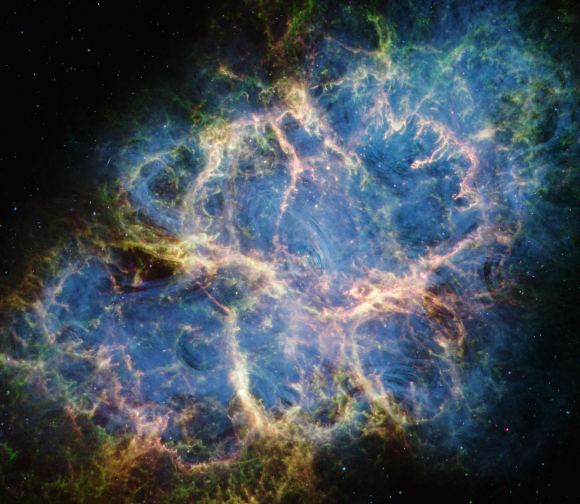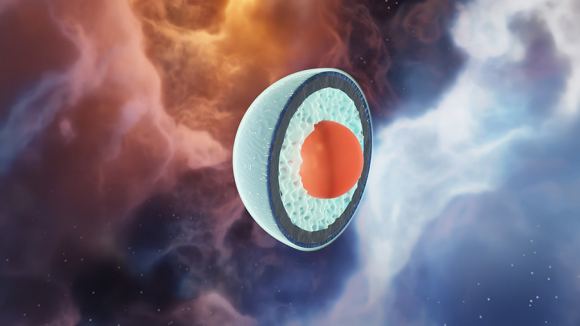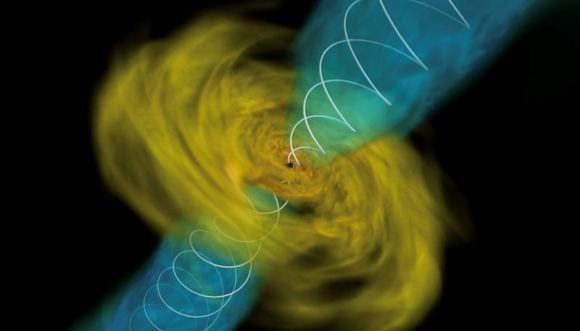When neutron stars dance together, the grand smash finale they experience might create the densest known form of matter known in the Universe. It's called "quark matter, " a highly weird combo of liberated quarks and gluons. It's unclear if the stuff existed in their cores before the end of their dance. However, in the wild aftermath a neutron-star merger, the strange conditions could free quarks and gluons from protons and neutrons. That lets them move around freely in the aftermath. So, researchers want to know how freely they move and what conditions might impede their motion (or flow).
These weird stars are hugely dense and strange collections of neutrons. So, when two of them dance and merge, they change shape under the pressure of the merger. They also heat up. The conditions eventually change the states of matter in their cores. According to Professor Aleksi Vuorinen of the University of Helsinki, Finland, this is what astronomers think happens during neutron star mergers. However, he points out nobody completely understands those conditions and how quarks behave in them. "Describing neutron-star mergers is particularly challenging for theorists because all conventional theoretical tools seem to break down in one way or another in these time-dependent and truly extreme systems", he said.
How Neutron Star Collisions Involve Quarks
In the cosmic zoo, neutron stars are among the weirder denizens. They're the highly magnetized leftovers of old supermassive stars that died in supernova explosions. The catastrophic collapse of the dying star creates a solid ball of neutrons where the stellar core once existed. Some spin very rapidly and send signals out to space. The Crab Nebula pulsar is a good example of such an object. Its core spins some 30 times per second and its signal shows up as regular pulses in radio frequencies, gamma and x-ray wavelengths. That's why it's called a "pulsar".
When neutron stars merge, obviously they mix and mingle their contents. Researchers want to know the viscosity of the material created in the merger. Essentially, this would be a measure of how strongly particle interactions would resist flowing. Or, think of it as measuring how "sticky" the flow of the quark soup would be. A thick quark soup would flow more slowly while a thin one would move faster. The idea is to understand the conditions and what they do to affect the flow of quarks during a merger.
Theories about Sticky Quarks
Researchers want to define the so-called "bulk viscosity" of the material created during the neutron star merger. Essentially, bulk viscosity describes the energy loss as the system involved in the merger experiences radial oscillations. They show how the quark-gluon density changes in a regular, periodic way. Vuornin and colleagues set out to determine the bulk viscosity of the quark matter involved in such a collision. They studied the problem using two theoretical methods, one invoking principles of holography and the other on a quantum field study called perturbation theory.
Essentially, the holographic approach looks at the quark matter problem as a factor of the densities and temperatures that occur during neutron star collisions. The team is interested in something called "quantum chromodynamics." That's the study of interactions between the quarks and gluons in the material created by the collision.
The perturbation theory looks at the strength of the interactions between those particles. By applying both methods, the team was able to characterize the bulk viscosity, i.e. the "stickiness" of the quark matter. Then, they could figure out that its stickiness occurs at lower-than-expected temperatures. It's a big step forward in understanding the behavior of neutron star matter during mergers. "These results may also aid the interpretation of future observations. We might for example look for viscous effects in future gravitational-wave data, and their absence could reveal the creation of quark matter in neutron-star mergers," adds University Lecturer Niko Jokela.
Using Physics and Quantum Theory to Delve into a Neutron Star
No one has ever been inside the strange universe inside the neutron star. However, it's got to be one of the weirder places in the cosmos. As mentioned, they're made simply of neutrons—combos of protons and electrons. Unlike most stars, they don't radiate heat and whatever residual heat they do contain dissipates over time. These odd objects do have extremely strong magnetic fields.
Neutron stars are incredibly dense. Just a small amount of their material (about the size of a regular wallet) would weigh around 3 billion tons. That makes these odd stars the second-most dense objects in the Universe, after supermassive black holes. Astronomers and particle physicists are interested in them because they can offer insight into such topics as superconductivity, the behavior of dense fluids, and a topic called quantum chromodynamics. Studying the collisions of these superdense objects also offers insight into the growth of these objects after their original formation in catastrophic supernova explosions.
For More Information
Neutron-Star Mergers Illuminate the Mysteries of Quark Matter
Estimate for the Bulk Viscosity of Strongly Coupled Quark Matter Using Perturbative QCD and Holography
Quantum Chromodynamics
 Universe Today
Universe Today



